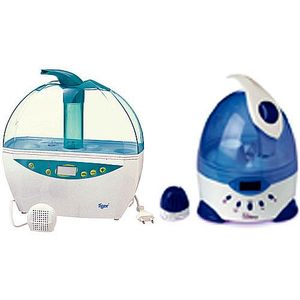Maintenance conditions of African violets. Air humidity and CO2 level
 For African violets, tropical forest plant, the optimal air humidity is 70-75%, and for the rooting of the cuttings and for the newly planted saplings, the air humidity can be even 80-90%.
For African violets, tropical forest plant, the optimal air humidity is 70-75%, and for the rooting of the cuttings and for the newly planted saplings, the air humidity can be even 80-90%.
In apartments, the air humidity is usually 40%, low level even for humans.
The optimal humidity for tenants is around 60%, which is actually acceptable for violets as well (mature violets from more resistant varieties, withstand an air humidity of 40%).
Increasing the air humidity level up to 60% is necessary for both a collection of African violets, as well as for their owner and it is as necessary as air conditioners are used during hot weather. Among other things:, You must mentioned that air conditioning systems dry the air in the room.
What measures should we take to maintain air humidity within normal limits?
First of all, we will get a hygrometer and measure the humidity of the air in the house. If it is below 50%, further action will be taken.
The most rational solution is to purchase a humidifier. The humidifier has a cold and very fine vapor system that does not allow the formation of dampness or mold. Properly positioned and adjusted according to the size of the room, He will provide the necessary comfort.
Before spraying, Water is disinfected and purified at a high temperature, thus preventing the spread of bacteria or viruses.
The following types of humidifiers are known:
1. Hot steam humidifier. Water is boiled in a special vessel and evaporated. The advantages of this type of humidifier are::
– The air in the room is enriched only with water.
– It is acceptable in terms of price.
Disadvantages:
– consumes a lot of electricity.
– poses danger to children;
– may exceed the normal limits of room air humidity.
2. Humidifier with natural hydration. In a plastic container filled with water lay a sponge and a fan. The sponge absorbs water from the tank and the fan evaporates it.
Advantages:
– The air is enriched exclusively with water;
– not expensive;
– consumes little electricity;
– does not exceed the normal limits of air humidity in the room.
Disadvantages:
– The sponge changes over time. Inside it bacteria can multiply.
3. Ultrasonic humidifier. Using this type of humidifier, Water does not evaporate but is dissipated under the influence of ultrasound.
Advantages:
– have an acceptable price;
– consumes little electricity;
Disadvantages:
– water is sprayed, and salts, Impurities, Chlorine in its composition after evaporation is deposited on surrounding furniture or objects;
– Some platforms are sensitive to ultrasound;
– the optimum degree of air humidity can be exceeded;
– contains components that will be replaced over time.
4. Air Purifier. It is composed of a tank that fills with water. Several rotating discs are partially immersed in this tank, Air is blown through the discs by a fan, evaporating water from the tank.
Advantages:
– The air is enriched exclusively with water;
– consumes little electricity;
– does not exceed the normal limits of air humidity in the room;
– purifies the air in the room (impurities from the air component are deposited on the walls of the tank).
Disadvantages:
– It's expensive.
All types of humidifiers presented above, They are also equipped with a number of functions and accessories:
– hygrometer or sensors showing the degree of humidity in the room;
– Hygrostat (keeps the humidity of the air in the room constant;);
– operating time during the night;
– containers for essential oils that allow air flavoring;
– ionization of room air;
– sound or optical indicator indicating the water level in the tank;
– filter against limescale deposits;
– Spraying power.
The above functions and accessories can be found in the purchase price of the humidifier, which ranges between $35-215.
African violets that grow in rooms with specially designed shelves create around them a microclimate with high air humidity. You can convince yourself of this fact, if you measure the humidity of the air on the shelves with violets.
If the air in the room is dry, its humidity level is 40%, A number of measures can be taken to raise the humidity of the air: Containers with water will be placed around the plants, Wet sphagnum or wet expanded clay in which pots with violets are placed (The plates under the pots must protect them from moisture entering the soil in the pot).
A humidity of 80-90% around the newly planted cuttings or wells is ensured by using microgreenhouses. The top shelves with seedlings or cuttings are covered with polyethylene, ensuring a humid and warm microclimate for plants;.
As a microgreenhouse, you can also use an aquarium placed on the side or more voluminous plastic boxes from pastries.
Microgreenhouses will be aired 1-2 times a day, and plants in microgreenhouses will be kept under strict observation: Conditions inside the microgreenhouse are favorable not only for the development of planes, but also for various bacteria and fungi that harm violets.
Carbon dioxide is also an important parameter for the growth and development of Saintpaulia. Air concentration measurement is carried out in specially designed rooms. If you are among the lucky ones who can afford this measurement, then CO2 concentration of 750-1500 ppm favors the harmonious development of plants.

